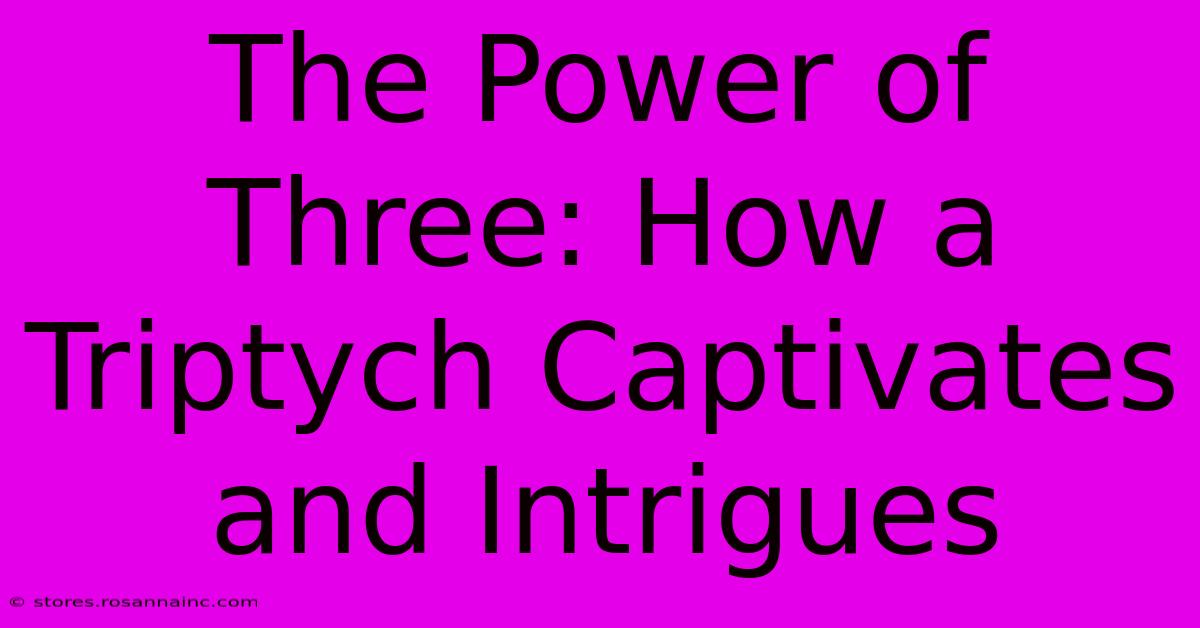The Power Of Three: How A Triptych Captivates And Intrigues

Table of Contents
The Power of Three: How a Triptych Captivates and Intrigues
The human mind is drawn to patterns, and few are as visually compelling as the triptych. This three-panel artwork, with its inherent structure and potential for narrative depth, has captivated audiences for centuries. From iconic religious masterpieces to modern abstract expressions, the triptych's enduring appeal lies in its unique ability to tell stories, evoke emotions, and intrigue the viewer. This article delves into the power of three and explores why the triptych format remains a potent tool for artistic expression.
Understanding the Triptych's Structure
The triptych's strength lies in its inherent framework. The three panels, often hinged together, create a dynamic interplay between individual scenes and the overall composition. This structure allows artists to:
-
Tell a story: Each panel can represent a stage in a narrative, unfolding a story across the artwork's surface. This sequential approach encourages engagement, as viewers piece together the narrative. Think of the classic altarpieces depicting the Annunciation, Crucifixion, and Resurrection – a powerful story told in three acts.
-
Create visual rhythm and contrast: The arrangement of three panels facilitates a natural rhythm. Artists can use this to their advantage, playing with contrasting colors, styles, or even moods across the panels. The central panel often holds the focal point, flanked by complementary or contrasting elements.
-
Offer multiple perspectives: A triptych can offer multiple viewpoints on a single subject or theme. Each panel can present a different aspect, inviting viewers to interpret the work from various angles and develop a richer understanding.
The Psychology Behind the Power of Three
The appeal of the triptych goes beyond its structural advantages. The number three holds a significant place in human psychology and culture:
-
Rule of three in rhetoric: This principle suggests that a list of three items is more memorable and persuasive than longer lists. This same principle applies to visual art, making the triptych inherently more engaging.
-
Symbolism and narrative: The number three often symbolizes the Holy Trinity, the past, present, and future, or the beginning, middle, and end – concepts that lend themselves easily to artistic interpretation within the triptych format.
-
Cognitive ease: Our brains find patterns pleasing and easy to process. The structured format of the triptych provides this cognitive ease, making it a visually satisfying experience.
Examples of Captivating Triptychs Throughout History
The triptych's enduring legacy is evident in masterpieces spanning centuries and artistic movements:
-
Religious Triptychs: From the early Flemish masters like Jan van Eyck (e.g., Ghent Altarpiece) to the iconic works of Matthias Grünewald (Isenheim Altarpiece), religious triptychs dominated the artistic landscape for centuries, often depicting biblical narratives with breathtaking detail and emotional intensity.
-
Renaissance and Baroque Triptychs: The Renaissance saw a continued exploration of the triptych format, with artists like Hieronymus Bosch employing it to create surreal and often unsettling works (The Garden of Earthly Delights). The Baroque period witnessed artists like Peter Paul Rubens utilizing the triptych for dramatic compositions filled with vibrant colors and movement.
-
Modern and Contemporary Triptychs: Contemporary artists continue to embrace the triptych, adapting it to diverse styles and themes. From abstract expressionism to pop art, the three-panel format provides a versatile framework for exploring a wide range of visual concepts.
Conclusion: The Enduring Power of the Triptych
The triptych's enduring power stems from a potent combination of structural elegance, psychological impact, and its capacity to engage the viewer on multiple levels. Whether telling a compelling narrative, exploring complex themes, or simply delighting with its visual harmony, the triptych continues to capture the imagination and intrigue audiences worldwide. Its ability to weave together individual elements into a cohesive whole, creating a whole greater than the sum of its parts, makes it a testament to the enduring power of artistic innovation and the captivating allure of three.

Thank you for visiting our website wich cover about The Power Of Three: How A Triptych Captivates And Intrigues. We hope the information provided has been useful to you. Feel free to contact us if you have any questions or need further assistance. See you next time and dont miss to bookmark.
Featured Posts
-
The Sdsu Aztecs Secret Weapon Unlocking The Potential Of Their 2021 Recruits
Feb 06, 2025
-
Embrace Your Unique Shape A Comprehensive Guide To Dressing The Inverted Triangle Body Type
Feb 06, 2025
-
10 Second Progress Indicator The Secret To Boost User Engagement
Feb 06, 2025
-
Embark On A Journey Of Heartfelt Service Join The Compassion International Job Family
Feb 06, 2025
-
Orange Roses The Ultimate Guide To Meaning Symbolism And Emotions They Convey
Feb 06, 2025
